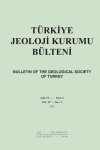
-
2025
-
2024
-
2023
-
2022
-
2021
-
2020
-
2019
-
2018
-
2017
-
2016
-
2015
-
2014
-
2013
-
2012
-
2011
-
2010
-
2009
-
2008
-
2007
-
2006
-
2005
-
2004
-
2003
-
2002
-
2001
-
2000
-
1999
-
1998
-
1997
-
1996
-
1995
-
1994
-
1993
-
1992
-
1991
-
1990
-
1989
-
1988
-
1987
-
1986
-
1985
-
1984
-
1983
-
1982
-
1981
-
1980
-
1979
-
1978
-
1977
-
1976
-
1975
-
1974
-
1973
-
1972
-
1971
-
1970
-
1969
-
1968
-
1966
-
1964
-
1963
-
1961
-
1959
-
1958
-
1955
-
1954
- 1953
-
1952
-
1951
-
1950
-
1949
-
1948
-
1947
Abstract: The principal mountains of the region studied, are Artos (3475m), Pelli (3060 m), Singer (2900 m), Arnas (3550 m) ,and Kuvveşehap (3500 m).The stratigraphy of the southeastern region of Lake Van is somewhat complicated.The stratigraphic column consist of the following: Paleozoic (Upper Permian), Upper Cretaceous (Maestrichtian), Upper Cretaceous-Paleocene, Eocene,Neogene, ,and Quaternary.Quartzites, Limestones, Crystalline Limestones ,and Schists make up the Upper Permian in the area. Schwagerina, Parafusulina, Polydiexodina were identifiedin the limestone member.The Conglomerates, foliated limestones, Globigerina limestones ,and radiolarites form the Upper Cretaceous.In the last two fossiliferous units, Globigerina cf. cretacea, Globotruncanalinnei d`Orb. Globotruncana cf. stuarti J. de. Lapp. Cyclolites krumbecki Stef.,Trochosmilia bilobata Mich.; Hippurites loftusi Wood, Exogyra columba Lamk.,Loftusia elongata, Lagena diffringens J. de Lapp. were identified.A mixed facies of limestones, marls ,and sandstones, overlay the Upper Cretaceous. Due to fossil content this facies is placed in the Upper Cretaeeous ,and Paleocene; Miliolidae, Nummulites sp. Miseellanea miscella cf. d`Arch, Lithophyllum,Globigerina cf. cretacea, Globotruncana cf. stuarti J. de Lapp. were identified inthe limestone units.
Abstract: Many years ago we made an excursion in the area of Gördes where wespent a few hours ,and then came back to Salihli. Between these two townswe collected a number of minerals ,and stones for the Geological Department of Ankara where we despached them. Very interesting results havabeen obtained from the examination of these minerals and stones.I have come to the conclusion that that it is worth to give a brief explanation about some of these stones ,and minerals which are interesting asregard their geological ,and economical aspects.
Abstract: Westlich des km. 229 der Eisenbahnlinie Ankara-Kayseri in der Naehedes Dorfes Çangılı befindet sich im Granit ein Fluoritgang mit einer Dickevon 70-75 cm. und einer Höhe von etwa 2 m.Das granitische Nebengestein gehört zu einer, sich etwa im DreieckYozgat-Keskin-Kırşehir befindenden, Reihe von kleineren und grösseren Aufschlüssen, die wir als <
Abstract: After general principles of the formation of rendzina soils ,and theprominent influence of parent material over climatogenic characteristicshave been briefly discussed, the rendzina development of Bursa region,Western Anatolia explained.Two profiles almost witli no distinct B horizons, one rich in parent material fragments ,and the other of finer texture, are described.
Abstract: Im Laufe des Sommers 1952 führte einer der Verfasser (van derKaaden) im Auftrag des Maden Tetkik ve Arama Enstitüsü, Ankara, geologisch-chromitlagerstaettenkundliche Untersuchungen im Gebiet vonGürleyik Köy, nördlich von Fethiye, Provinz Muğla (S. W.-Türkei) durch(2).Anschliessend wurden im Labor des M. T. A. Enstitüsü (i. Topaloğluund N. Kırağlı) insgesamt 11 Vollanalysen von Chromiterzen dieses Gebietes ausgeführt. Es sollte versucht werden, die Frage zu klaeren, ob dieZusammensetzung des Chromits.
Abstract: Die in den Jahren 1947, 48, 50, 51 und 1952 durch das Institut für Lagerstaettenforschung der Türkei (M.T.A.) durchgeführten Bausit-Untersuchungen wurden vom Unterzeichneten geleitet.Als Grundlage für dieses Studium liegen vor: Über 1000 Bauxit-Analysen, einige Hundert Dünnschliffe, geologische Kartierungenim Masstabe 1:25.000 bezw. 1:10.000, sowie zahlreiche Lagerkarten undSkizzen. Ausserdem mehr als 1000 Schürfungen und Graeben, sowie Untertagebaue in der Gesamtlaenge von rund 900 m. Eine allgemein geologische Beschreibung des Akseki-Bauxite wurdebereits von Blumenthal-Göksu(Lit. 18) gegeben. Hier folgen geologischeBeobachtungen, die allein Bauxitlager betreffen.
Abstract: In a previous stucly on the Pontian fauna from Küçükyozgat I hadstated that, in addition to the already determined species, there werestill some indetermined specimens of Pontian gazelles in the Collection.(3) As since that time I have determined the species of a horn-coreof a gazelle, I have considered it worthwhile to publish it in a short note,since the determination of other specimens of gazelles, other forms ,andthe preparation of the full report will take considerable time.The horn-core described in this report is from the whitish calcareous marls of lacustrine origin south of Küçükyozgat, the fauna ofwhich I have labelled as "Küçükyozgat fauna

 TMMOB
TMMOB